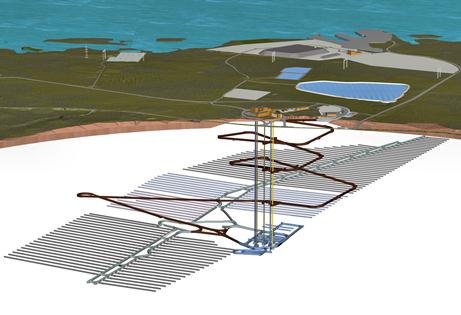Finnish regulator approves Posiva's waste repository plan
12 February 2015
Finland's radiation and nuclear safety authority (STUK) has given its backing to Posiva's application to construct a final repository and waste encapsulation plant.
 |
| The Olkiluoto repository will consist of a network of disposal tunnels up to 450 metres below ground (Image: Posiva) |
Posiva, a waste management specialist jointly owned by Finnish nuclear utilities Fortum and TVO, submitted its application to the Ministry of Employment and the Economy in December 2012 with the aim of permanently storing the used nuclear fuel from its owners' nuclear power plants. That followed approval by Finland's parliament of the decision-in-principle for the project in 2001. The site for the repository at Olkiluoto, in the municipality of Eurajoki, was selected in 2000.
STUK informed the ministry of its support for the plan on 11 February, stating that the repository "can be built to be safe".
"We have already assessed that the operational and long-term safety of the nuclear waste facility are on a sufficiently high level for granting the construction licence," STUK inspector Jussi Heinonen said. "This is a new type of facility, which is why the appropriate approach is to progress in phases and, at the same time, assess and elaborate the designing of the facility on the basis of the accumulated knowledge. For example, we will gain more detailed knowledge about the local characteristics of rock at the final disposal depth once the construction of the facility begins."
Swedish used fuel management company Svensk Karnbranslehantering AB (SKB) welcomed the development, saying that the plan was similar to a Swedish permit consideration for a repository for used nuclear fuel at Forsmark. The planned KBS-3 repository for used nuclear fuel would use the same storage method as that which SKB wants to use, it said.
Posiva has reached an important milestone in its nuclear program, SKB president Christopher Eckerberg said. "Although there are two separate state trials in our respective countries, SKB and Posiva are working closely on the disposal method and its further development," he said.
Following statements by the ministry and other stakeholders, the Finnish government will then decide whether a construction licence for the repository can be issued.
"STUK's statement will be of great significance to obtaining the [construction] licence," Posiva said.
STUK said that its statement to the ministry was based on a safety review and assessment it conducted to ensure that the requirements of the country's nuclear energy act are met.
The government will also need to approve an operating licence before the proposed repository can start operations. Posiva is expected to apply for that licence in 2020, STUK said.
The project for final disposal of used nuclear fuel "will continue into the 2100s", STUK said, and the continuous improvement in safety will be "the leading principle". In its safety case, Posiva analyses a number of different scenarios and related risks and states that if any radiation exposure occurred, the dose would be very low, STUK added.
According to law, final disposal may cause an annual radiation dose of no more than 0.1 millisieverts to an exposed individual after the facility is closed. In order for any radiation exposure to occur at all, radioactive substances in the nuclear fuel would need be released from the canister and carried in groundwater to the ground surface and, from there, to people through food, STUK said. Based on the analyses, even if this were to occur, the radiation exposure would be one 10,000th of the specified 0.1 millisievert limit, it said. The average annual radiation dose received by Finns is approximately 3.2 millisieverts. A 0.1 millisievert exposure is possible during one cranial x-ray examination or one transatlantic flight.
Following parliament's decision-in-principle, STUK "systematically increased" its nuclear waste management expertise and resources, as well as international co-operation in this area, "in order to ensure competent and careful handling of safety matters," STUK director general Petteri Tiippana said.
The assessment of Posiva's construction licence application took two years and the contribution of STUK's experts was about 18 man-years of work. Other experts in Finland and abroad contributed seven man-years.
If the construction licence is granted, STUK will supervise building of the nuclear waste facility and may, as necessary, require changes to the approved design, it said.
"In addition to the construction of the encapsulation plant and final disposal facility, we will pay particular attention to ensuring that the final disposal system can be installed as planned. This is the first time that this type of facility will be built," Heinonen said. "Therefore, during the construction of the final disposal tunnels, it is important to assess the functionality of the rock construction methods and the classification system and to identify areas for development and possibilities for improving safety. Studies to further ensure the functioning of the copper capsule and the surrounding clay material are also necessary," he said.
Researched and written
by World Nuclear News